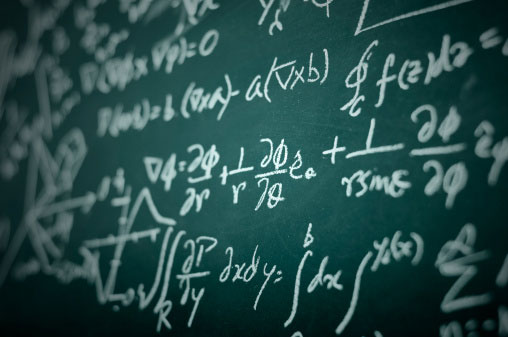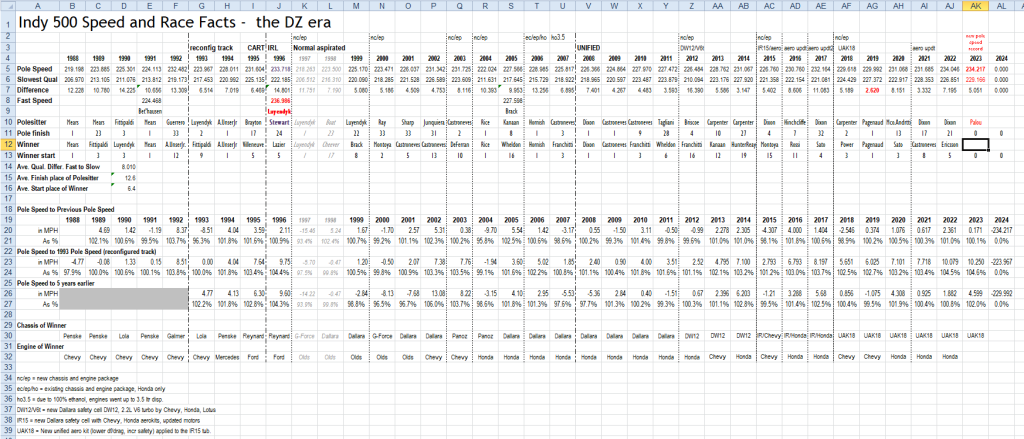As the excitement builds for my annual trek to Indy, I always spend some time watching old race videos, looking through past pictures and programs, and reviewing the small amount of race statistics I find interesting or keep.

Many of you are already familiar with the annual updates to my #Greatest33 tally, and some may also even recall my Indyfacts spreadsheet (which tracks some select hallmark statistics starting with 1988) noted in this post back in 2018. I guess it’s fairly clear that I like statistics and wasting portions of my life creating spreadsheets that generally serve no greater good except to perhaps help keep my mind nimble and away from more pressing chores.
This year I’ve put off reviewing the Greatest33 numbers until after the race, but I did dive into the most recent 35 races of my Indyfacts sheet a bit more than typical. In doing so, I think I feel totally, 100%, lead-pipe locked-in on a winner for this race. Or maybe two. And there’s also data pointing to a strong third candidate. You get the idea.

In summary, from the most recent 35 Indy 500s, the winner has most frequently come from the first starting position nine times. However, that also means that all of the other positions have won approximately 75% of the time (26 of 35). 19 of those 26 have come from outside the first row. Yet another interesting pair of statistics shows the average finishing position of the polesitter has been 6th and the average starting position of the winner has been 12th.
Rows of 3 – When considering the effect of starting row, the first row dominates the wins with 16 of 35. The following rows are; second row = 6, third row = 3, fourth row = 4, fifth row = 2, sixth row = 3, seventh row = 1, and none from eighth through eleventh rows. When we dive into individual starting positions, the numbers get a bit weirder.
Positionally Speaking – Instead of a nice steady downward tangent curve starting from the 9 wins from pole, to 0 wins at 20th, we get a vertical zig-zag as second, fourth, sixth, ninth, tenth, and eleventh all have just 1 win to their positions, while seventh, fourteenth, and eighteenth register no wins in 35.
This would mean Veekay (2nd), O’Ward (4th), Dixon (6th), Kanaan (9th), Ericsson (10th), and Pedersen (11th) have precious little chance despite their generally excellent starting positions and Rossi (7th), and McLaughlin (14th) should perhaps not bother to show up.
Starting positions 12 and 16 have perhaps over-achieved with two wins apiece. Does that make them more or less likely to repeat?
I’m sure you’re now as numbed to numbers as I am to writing about them. So what, after all of this calculating, regurgitating, and pontificating can I possibly find?
KISS – Keep It Simple, Stupid. It’s been 6 races since the polesitter has won and prior to that, another 10, meaning position 1 has been underperforming in the last while. As an intangible consideration, I also feel that as exciting as the last few have been, we’re due for a bit of a boring race (see also; 2003, 1993,). In addition to the fact that this driver has been regularly in the mix for wins in the previous three races, I’m (most-predictably) predicting the winner of the 2023 Indianapolis 500 will be your polesitter, Alex Palou.
Picking a dark-horse is as subjective as defining what constitutes a ‘dark-horse’. The numbers, however, again push me toward a position. This one hasn’t won in the last 35, despite all others around it having won, and belying its rather fair starting spot – P14. This position also happens to jockey the horses of Chevrolet which hasn’t won in 4 races, so again, perhaps overdue. Starting 14th, my dark horse pick is Scott McLaughlin.
What does the universe tell you about the winner of this year’s race? Leave your guess in the comments below and let’s see who’s most attuned to the fates.
At any rate, have a great race weekend and I’ll be back next week to recap the guesses and see what has happened to the #Greatest33.
